NCERT Exemplar Solutions for Class 12 Biology chapter 16 Environmental Issues
These Solutions are part of NCERT Exemplar Solutions for Class 12 Biology. Here we have given NCERT Exemplar Solutions for Class 12 Biology chapter 16 Environmental Issues
Multiple Choice Questions
Question 1.
Non-biodegradable pollutants are created by
(a) nature
(b) excessive use of resources
(c) humans
(d) natural disasters.
Answer:
(c) : Non-biodegradable pollutants are created by humans which effects our environment adversely They have the tendency to accumulate, as they are not degraded or broken down naturally into harmless compounds e.g. DDT (dichloro- diphenyl trichloroethane), BHC (Benzene hexachloride), polythene bags, etc.
Question 2.
According to the Central Pollution Control Efoard, particles that are responsible for causing great harm to human health are of diameter
(a) 2.50 micrometers
(b) 5.00 micrometers
(c) 10.00 micrometers
(d) 7.5 micrometers.
Answer:
(a) : Particulate matter causing air pollution is differentiated into settleable (larger than 10 pm) and suspended (less than 10 pm) particulate matter. According to CPCB, particles of 2.5 pm and lesser diameter are most harmful to human health as they can pass deep into lungs causing breathing and respiratory problems.
Question 3.
The material generally used for sound proofing of rooms like a recording studioand auditorium, etc is
(a) cotton
(b) coir
(c) wood
(d) styrofoam.
Answer:
(d)
Question 4.
Compressed Natural Gas (CNG) is
(a) propane
(b) methane
(c) ethane
(d) butane.
Answer:
(b) : Compressed Natural gas (CNG) is mostly methane. It is better alternative to petrol or diesel in terms of adverse effects on environment. In 2002, public transport vehicles in Delhi switched to CNG by the order of government as it bums more efficiently and cause lesser pollution.
Question 5.
World’s most problematic aquatic weed is
(a) Azolla
(b) Wolffia
(c) Eichhornia
(d) Trapa.
Answer:
(c) : Eichhornia crassipes (water hyacinth) is world’s most problematic aquatic weed, also called “Terror of Bengal”. Because of its very high rate of growth, it can cover the surface of whole water bodies, choke them and cause a threat to other aquatic life forms.
Question 6.
Which of the following causes biomagnification?
(a) SO2
(b) Mercury
(c) DDT
(d) Both (b) and (c)
Answer:
(d) : Biomagnification refer to increase in concentration of toxicant at successive trophic levels. This happens because a toxic substance accumulated by an organism cannot be metabolised or excreted, and is thus passed on to the next higher trophic level. This phenomenon is well-known for mercury and DDT.
Question 7.
The expanded form of DDT is
(a) dichloro diphenyl trichloroethane
(b) dichloro diethyl trichloroethane
(c) dichloro dipyrydyl trichloroethane
(d) dichloro diphenyl tetrachloroacetate.
Answer:
(a)
Question 8.
Which of the following material takes the longest time for biodegradation?
(a) Cotton
(b) Paper
(c) Bone
(d) Jute
Answer:
(c) : Bones are made up of proteins (mainly collagen), inorganic minerals (calcium, hydroxyapatite) and organic ground substance. Out of these four options bone degradation will take the longest time. Collagen, because of its unique structures in one of the most resistant proteins to degradation. Inorganic ions like Ca , further strengthen the bones.
Question 9.
Choose the incorrect statement.
(a) The Montreal protocol is associated with the control of emission of ozone depleting substances.
(b) Methane and carbon dioxide are greenhouse gases.
(c) Dobson units are used to measure oxygen content.
(d) Use 6f incinerators is crucial to disposal of hospital wastes.
Answer:
(c) : Dobson units (DU) are used to represent the concentration or thickness of ozone (03) in our atmosphere. 100 = lppb (parts per billion). Thickness of ozone is more over equators than over poles. Ozone layer in stratosphere protects us from the harmful effects of UV radiation (including skin cancer, inflammation of cornea etc).
Question 10.
Among the following which one causes more indoor chemical pollution?
(a) Burning coal
(b) Burning cooking gas
(c) Burning mosquito coil
(d) Room spray
Answer:
(a) : Among the given four options, both burning of coal and burning of mosquito coil will cause chemical pollution, but burning of coal will cause more pollution. The main ingredient in mosquito coils is pyrethrum C (a natural extract from the chrysanthemum flower). At high doses, it is responsible for various respiratory disorders. The coal leads to release of a wide array of air pollutants (COX, SOX, NOX etc.). Among these CO is very dangerous, it interfer with breathing process. People are generally advised not to sleep with coal burning in the closed room.
Question 11.
The green scum seen in the fresh water bodies is
(a) blue green algae
(b) red algae
(c) green algae
(d) both (a) and (c).
Answer:
(d) : The green scum seen in water bodies includes both green algae as well as blue-green algae. The excessive growth of such bloom forming algae is mainly because of presence of phosphates or nitrates in the water body (eutrophication). Such algal blooms can choke the water body. Green algae and blue-green algas (cyanobacteria) both are photosynthetic and decrease the dissolved oxygen content of water body. This kills much of flora and fauna of that water body. Later on, when microorganisms decompose these algae, further reduction in dissolved oxygen occurs.
Question 12.
The loudness of a sound that a person can withstand without discomfort is about
(a) 150 db
(b) 215 db
(c) 30 db
(d) 80 db.
Answer:
(d)
Question 13.
The major source of noise pollution, world wide is due to
(a) office equipment
(b) transport system
(c) sugar, textile and paper industries
(d) oil refineries and thermal power plants.
Answer:
(b)
Question 14.
Match correctly the following and choose the correct option
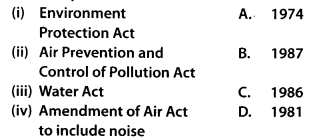
The correct matches is
(a) (i) – C, (ii) – D, (iii) – A, (iv) – B
(b) (i) – A, (ii) – C, (iii) – B, (iv) – D
(c) (i) – D, (ii) – A, (iii) – B, (iv) – C
(d) (i) – C, (ii) – D, (iii) – B, (iv) – A
Answer:
(a)
Question 15.
Catalytic converters are fitted into automobiles to reduce emission of harmful gases. Catalytic converters change unburnt hydrocarbons into
(a) carbon dioxide and water
(b) carhon monaaxide
(c) methane .
(d) carbon dioxide and methane.
Answer:
(a) : Catalytic converters are fitted ‘ into automobiles for reducing emission of poisonous gases. Rhodium and PlatinumPalladium are examples of catalysts used in catalytic converters. They convert unburnt hydrocarbons into carbon dioxide and water and carbon monoxides to CO2 and nitric oxide to N2 gas.
Question 16.
Why is it necessary to remove sulphur from petroleum products?
(a) To reduce the emission of sulphur dioxide in exhaust fumes.
(b) To increase efficiency of automobiles + engines.
(c) To use sulphur removed from petroleum for commercial purposes.
(d) To increase the life span of engine silencers.
Answer:
(a) : By removing sulphur from petrol and diesel, the emission of SO2 can be reduced , in exhaust. SO2 is a very harmful air pollutant. It can damage the vegetation by causing ,chlorosis. It can cause acid rain (by forming H2SO3 and H2SO4), damaging buildings and plants. In human beings it can cause irritation in eyes and damage to respiratory system (e.g. bronchitis).
Question 17.
Which pne of the following impurities is easiest to remove from wastewater?
(a) Bacteria
(b) Colloids
(c) Dissolved solids
(d) Suspended solids
Answer:
(d) : Suspended solids are relatively easier to remove from waste water. They constitute mainly sand, silt and clay. Most of these solids tend to settle if waste water is left undisturbed for sometime. They can be separated easily by physical means. Dissolved solids, both organic and inorganic (nitrates, phosphates etc) as well as bacteria and colloids are relatively difficult to separate.
Question 18.
Which one of the following diseases is not due to contamination of water?
(a) Hepatitis-B
(b) Jaundice
(c) Cholera
(d) Typhoid
Answer:
(a) : Hepatitis-B is caused by Hepatitis-B virus. It can be transmitted through blood transfusion, sexual contact, saliva and sharing of razors. It is not transmitted through contamination of water, as is the case with the rest of diseases.
Question 19.
Nuisance growth of aquatic plants and bloom forming algae in natural waters is generally due to high concentrations of
(a) carbon
(b) sulphur
(c) calcium
(d) phosphorus.
Answer:
(d) : Phosphorus in the form of phosphates as well as nitrates act as nutrients for the bloom-forming algae. Increased growth of algae because of these pollutants added to water bodies by human activities is called as cultural eutrophication. This literally, chokes the water body and lead to death of the organisms. Decomposition of these algae as well as dead water organisms, further deplete the dissolved oxygen content in water.
Question 20.
Algal blooms impart a distinct colour to water due to
(a) their pigments
(b) excretion of coloured substances
(c) formation of coloured chemicals in water facilitated by physiological degradation of algae
(d) absorption of light by algal.cell wall.
Answer:
(a) : Algal blooms are considered as pollutants of water, as they have very damaging effects on flora and fauna of that water body. They mostly consist of green algae and blue-green algae. The colour imparted by them depends on the colour of major pigment in them. For e.g., chlorophyll imparts the characteristic green colour. Also refer answer 19.
Question 21.
Match the items in Column-1 and Column-ll and choose the correct option.
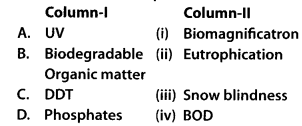
The correct match is:
(a) A-(ii), B-(i), C-(iv), D-(iii)
(b) A-(iii), B-(ii), C-(iv), D-(i)
(c) A-(iii), B-(iv), C-(i), D-(ii)
(d) A-(iii), B-(i), C-(iv), D-(i)
Answer:
(c)
Question 22.
In the textbook you came across Three Mile island and Chernobyl disasters associated with accidental leakage of radioactive wastes. In India we had Bhopal gas tragedy. It is associated with which of the following?
(a) CO2
(b) Methyl Isocyanate
(c) CFC’s
(d) Methycyanate
Answer:
(b) : In the night of December 2-3, 1984, gas clouds of methyl isocyanate (MIC) formed in Bhopal, Madhya Pradesh. The cause was leakage from the pesticide plant in union carbide India limited. The gas had acute health effects as well as long term effects. The acute effects lead to the death of more than 3000 people. Acute effects included suffocation, vomiting, pulmonary oedema as well as cerebral oedema.
Very Short Answer Type Questions
Question 1.
Use of lead-free petrol or diesel is recommended to reduce the pollutants emitted by automobiles. What role does lead play?
Answer:
Lead inactivates catalyst of the catalytic converter.
Question 2.
In which year was the Air (Prevention and Control of Pollution) Act amended to include noise as air pollutant.
Answer:
In 1987 the Air (prevention and control of pollution) act amended to include noise as air pollutant.
Question 3.
Name the city in our country where the entire public road transport runs on CNG.
Answer:
In Delhi the entire public road transport runs on CNG.
Question 4.
It is a common practice to undertake desilting of the overhead water tanks. What is the possible source of silt that gets deposited in the water tanks?
Answer:
The source of silt that get deposited in overhead water tank are soil particles, which are carried out with water from the source of supply like rivers etc.
Question 5.
What is cultural eutrophication?
Answer:
Ageing of lake at a faster rate due to presence of large amount of industrial and agricultural waste and domestic sewage produced as a result of human activities is called cultural or accelerated eutrophication.
Question 6.
List any two adverse effects of particulate matter on human health.
Answer:
The adverse effect of particulate matter on human health are:
- Breathing and respiratory problems, bronchitis, asthma.
- Irritation, inflammations and damage to lungs and premature death.
Question 7.
What is the raw material for polyblend?
Answer:
Any plastic waste is the raw material for polyblend.
Question 8.
Blends of polyblend and bitumen, when used, help to increase road life by a factor of three. What is the reason?
Answer:
Polyblend is a fine powder of recycled modified plastic. Polyblend prepared from plastic film waste increases the water repelling property of bitumen, which increases the life of roads to three times.
Question 9.
Mentfon any two examples of plants used as wind breakers in the agricultural fields.
Answer:
- Prosopis
- Casuarina
Question 10.
Name an industry which can cause both air and thermal pollution and as well as eutrophication.
Answer:
Fertiliser industry can cause both air and thermal pollution and as well as eutrophication.
Question 11.
What is an algal bloom?
Answer:
Excess of nitrates and phosphates from fertilisers rundown into ponds, lakes, streams which led to thick growth of planktonic algae called algal bloom. The scum formed is blue green in colour. It is toxic and leads to suffocation of aquatic organisms.
Question 12.
What do you understand by biomagnification?
Answer:
Biomagnification is increase in concentration of certain toxic chemicals in successive trophic levels of a food chain, this phenomenon is well-known for DDT and mercury etc.
Question 13.
What are the three major kinds of impurities in domestic wastewater?
Answer:
Three major kinds of impurities in domestic wastewater are :
- Suspended solid particles (Sand, Silt and Clay)
- Dissolved materials (nitrates, phosphates, sodium and calcium etc.)
- Colloidal particles (faecal matter, bacteria, cloth and paper fibres etc.)
Question 14.
What is reforestation?
Answer:
Process of restoring of a forest that once existed but was removed at some point of time in the.past is known as reforestation.
Question 15.
What is the best solution for the treatment of electronic wastes?
Answer:
Evencs is a scientific method of treating e-wastes in an environment friendly manner.
Short Answer Type Questions
Question 1.
Is it true carpets and curtains/ drapes placed on the floor or wall surfaces can reduce noise level. Explain briefly?
Answer:
Yes, it is true that carpets and curtain/ drapes reduce the noise pollution, because being porous in nature they absorb sound and recluce the noise level.
Question 2.
What is hybrid vehicle technology?. Explain its advantages with a suitable example?
Answer:
Technology that involves running of vehicles at dual mode of fuel i.e. Petrol and CNG, is known as hybrid vehicle technology.CNG is a better fuel because it is completely combustible and produces less pollutants. CNG also helps in conservation of fossil fuels.
Question 3.
Is it true that if the dissolved oxygen level drops to zero, the water will become septic. Give an example which could lower the dissolved oxygen content of an aquatic body.
Answer:
Yes, it is true that when the level of dissolved oxygen drops to zero, the water becomes septic. This happens when the amount of organic waste becomes very high and almost all the oxygen content is completely utilised by decomposers. E.g., addition of sewage water in a water body lowers 02 level.
Question 4.
Name any one green house gas and its possible source of production on a large scale. What are the harmful effects of it?
Answer:
Major green house gases are CO2– 60%, CH4-20%, CFCS-14% and N2O-6%. Out of which CO2 is present in maximum amount. Source of CO2 is burning of fossil fuels, volcanic eruptions and respiration process. Due to increased level of CO2 in the atmosphere global atmospheric temperature during the past century has increased to 0.6%. It is called global warming, which results in melting of polar ice caps and rise in sea level etc.
Question 5.
It is a common practice to plant trees and shrubs near the boundary walls of buildings. What purpose do they serve?
Answer:
Growing of plants near the boundary wall of jauildings is known as Green muffler scheme, which reduces the noise pollution by absorbing sound. They also help in trapping of dust particles.
Question 6.
Why has the National Forest Commission of India recommended a relatively larger forest cover for hills than for plains?
Answer:
National Forest Commission has recommended 33% forest cover for plains and 67% forest cover for hills (1988) in his National Forest Policy. Because, forest are responsible for controlling soil erosion, land slides and moderate the climate whereas plains provide land for human settlements.
Question 7.
How can slash and burn agriculture become environment friendly?
Answer:
In slash and burn agriculture, the farmers cut down the trees of the forest and burn the plant remains. The ash is used as a fertiliser and land is used for farming or cattle grazing. After that area is left for several years for recovery. Slash and burn agriculture can become environment friendly if rows of trees and shrubs are left intact, while clearing the area for cultivation which will prevent soil erosion and invasion of weeds. There will be quicker recovery of forest after the area is abandoned.
Question 8.
What is the main idea behind ” Joint Forest Management Concept” introduced by the Government of India?
Answer:
Joint forest management (JFM) committees are set up with joint effort of Government and local communities for protecting and managing forests in sustainable manner. Village communities work together with the government as share the benefits. Presently, there are 84632 JFM committees with 17.33 million hectare forest area under them. Around 85.28 lakh families are involve in them all over the country.
Question 9.
What do you understand by Snow-blindness?
Answer:
Snow blindness is a temporary blindness caused by inflammation of cornea due to absorption of UV-B radiations. It leads to diminishing of eye sight, photoburning and later permanent damage to cornea that results in actual cataract.
Question 10.
How has DDT caused decline in bird population?
Answer:
DDT is a persistent pollutant. Excessive use of DDT, increases its concentration in successive trophic levels in food chain due to its accumulation in fat. This phenomenon is known as biomagnification. High concen-tration of DDT distrub calcium metabolism in birds, which causes thinning of egg shell and their premature breaking that kills embryos eventually causing decline in bird population.
Question 11.
Observe the figure A and B given below and answer the following questions.
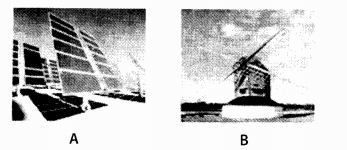
(1) The power generation by the above two methods is non-polluting—True/False.
(2) List any two applications of solar energy.
(3) What is a photovoltaic cell?
Answer:
- True. Figure A is solar energy panel
and figure B is wind mill. Both devices produce electricity, without polluting the environment. - Applications of solar energy are:
- Solar Cookers
- Solar water heater
- Solar battery driven car
- Photovoltaic cell is the solar cell which transforms solar radiant energy into electrical energy.
Long Answer Type Questions
Question 1.
Write a short note on electronic waste. List the various sources of e-wastes and the problems associated with its disposal.
Answer:
Irreparable computers and other electronic goods are known as electronic wastes (e-wastes). Electronic waste is produced by damaged or discarded electronic goods, computer parts, keyboard, monitor, mouse, central processing unit (CPU) etc. Most of e-waste is dumped at landfill sites. The e-waste consists of lead and mercury etc, which may get leaked into soil water. e-wraste should be disposed off either by incineration or pyrolysis or should be recycled.
Unlike developed countries, which have specifically built facilities for recycling of e-waste, in developing countries it is done manually. Thus workers are exposed to toxic substances present in e-waste. Recycling seems to be the best solution for treatment of e-waste provided it is carried out in eco- friendlv manner.
Question 2.
What is organic farming? Discuss the benefits of organic farming as a viable practice in the context of developing nations like India.
Answer:
Organic farming is a cyclical, zerowaste procedure where waste products from one process are cycled in as nutrients for other processes. This allows maximum utilisation of resources and increases the efficiency of production.
The land is cultivated by using techniques such as crop rotation, green manure, composting, biofertilisers and biopesticides etc. In developing nations like India, organic farming is important to meet the food demand, we are using excessive chemical fertilisers which are polluting our soil and water resources.
Benefits of organic farming :
- It reduces the use of chemical fertilisers and prevent from their ill effects.
- It controls pest without harming the environment.
- It produces nutritious and quality food.
- It helps in conservation of natural resources by their efficient utilisation.
- It maintains the soil fertility.
Question 3.
Water logging and soil salinity are some of the problems that have come in the wake of the Green Revolution. Discuss their causes and adverse effects to the environment.
Answer:
Water logging is submerging of land under water. Water logging is caused by excessive irrigation, Kutcha irrigation channels, presence of impermeable under-ground soil pans and improper drainage of water during irrigation. Besides affecting the crops, water logging draws salt to the surface of soil. Salt is deposited as a thin crust on the land surface, which leads to soil salination.
This decreases absorption capacity of water and mirterals by the root system of plants. Adverse effects :
- Water logging and soil salination cause loss of land productivity.
- Fertility of land reduces from 30 – 80%.
- Increased soil content affects the growth of crops and causes extreme damage to agriculture.
In India more than 20% irrigated land is damaged due to it.
Question 4.
What are multipurposetrees? Give the botanical and local names of any two multipurpose trees known to you and list their uses.
Answer:
Multipurpose trees are the trees that are deliberately grown and managed for more than one output. They supply food to us but at the same time supplies firewood or add nitrogen to the soil or supplies some other combination of multiple outputs.
- Plants like Ficus variegata (gulhar), Daucos carrota (Carrot), Phaseolus vulgaris (common bean), Coleus (Makandi) fix carbon monoxide a chief pollutant in air.
- Pinus (Pinus tree), Juniper us (common juniper), Quercus (oak) can use oxides of nitrogen.
- Biodiesel plants e.g., jatropha and Pongammia, Pinnatn used to produce biodiesel which can be used as a substitute for diesel.
Question 5.
What are the basic characteristics of a modern landfill site. List any three and also mention the reasons for their use.
Answer:
Characteristics of modern landfill include:
- Methods to contain leachate such as lining clay or plastic liners
- Compaction and covering of the waste to prevent it from being blown by wind.
- Installation of landfill gas extraction system to extract the gas for use in generation of power.
Landfilling is simple economic method which by recyfling and recovery of waste reduces waste. Modern landfill reduces the negative effects on the environment and on human health related to landfilling.
Question 6.
How does an electrostatic precipitator work?
Answer:
Electrostatic precipitators (ESPs) are most widely used devices to separate the particulate matter on the basis of charges. It can remove over 99% of particulate matter present in the exhaust from a thermal power plant. It has electrode wires that are maintained at several thousand volts, which produce a corona that releases electrons. These electrons attach to dust particles giving them a net negative charge. The collecting plates are grounded and attract the charged dust particles. The velocity of air between the
Question 7.
Observe figure and answer the following questions.
(1) What ecological term is used to describe the DDT accumulation at different trophic levels?
(2) List any one effect of DDT accumulation on birds.
(3) Will DDT accumulation lead to eutrophication?
(4) Does it affect the BOD?
(5) Name disease caused by accumulation of any heavy metal.
Answer:
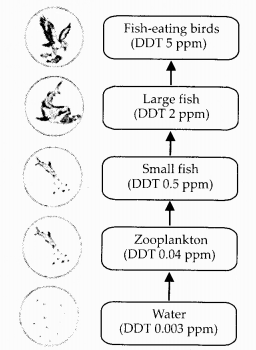
- The ecological term used to describe the DDT accumulation at different trophic levels is called biomagnification.
- High concentration of DDT disturbs the calcium metabolism in birds, which causes thinning of egg shell and premature breaking. The shell breaks during incubation. This causes decline in bird population.
- DDT accumulation does not lead to eutrophication because eutrophication is caused by excess of nitrates and phosphates and domestic sewage.
- BOD is the amount of oxygen required to decompose the biodegradable organic wastes. DDT is non bio-degradable waste and so does not affect BOD.
- Biomagnification of heavy metal mercury in the fishes and consumption of such fishes causes minamata disease in man. plates must be low enough to allow the dust to fall. It is most effective device to remove particulate pollutants.
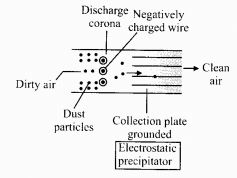
We hope the NCERT Exemplar Solutions for Class 12 Biology chapter 16 Environmental Issues help you. If you have any query regarding .NCERT Exemplar Solutions for Class 12 Biology chapter 16 Environmental Issues, drop a comment below and we will get back to you at the earliest.